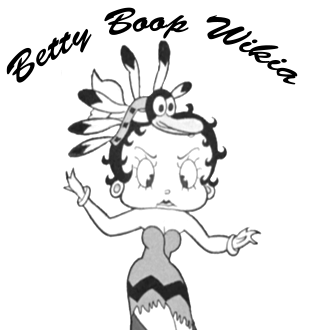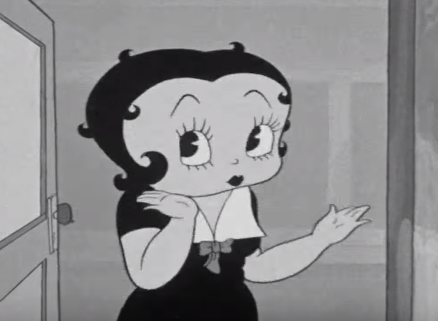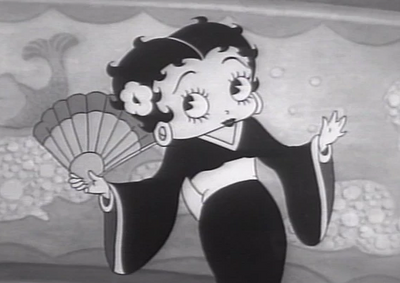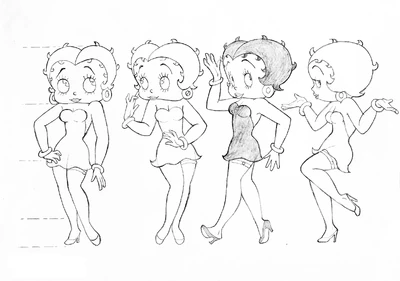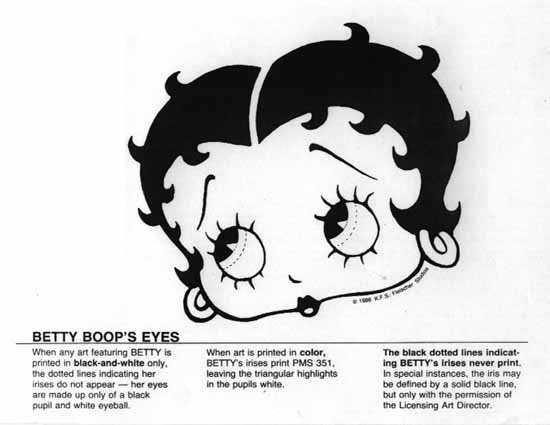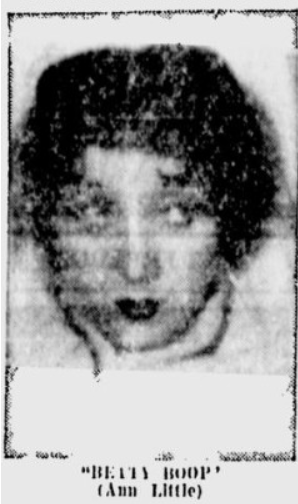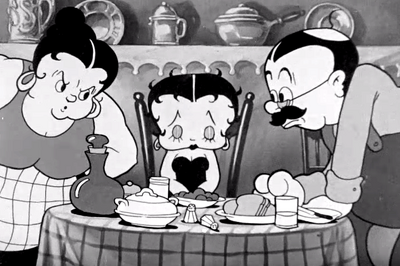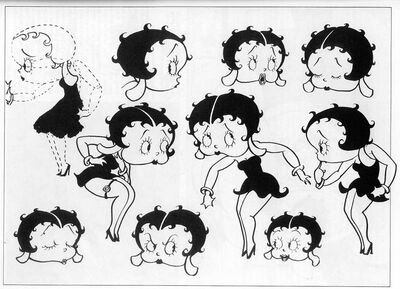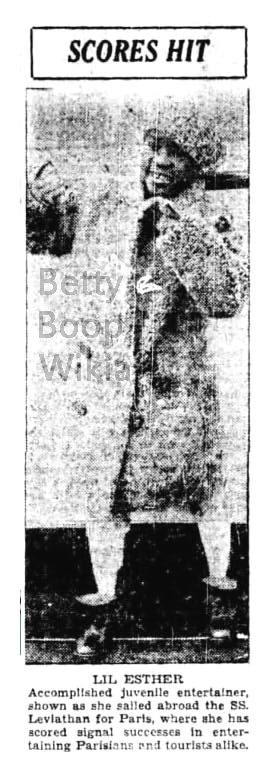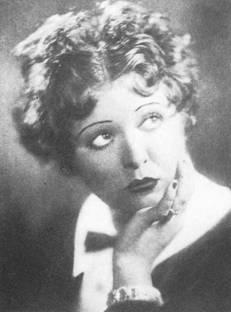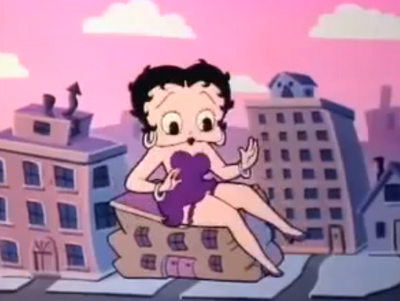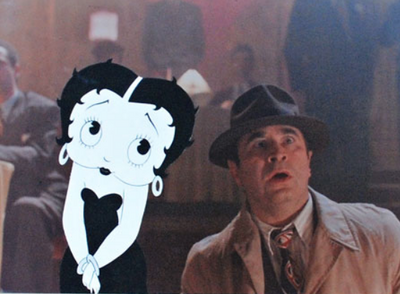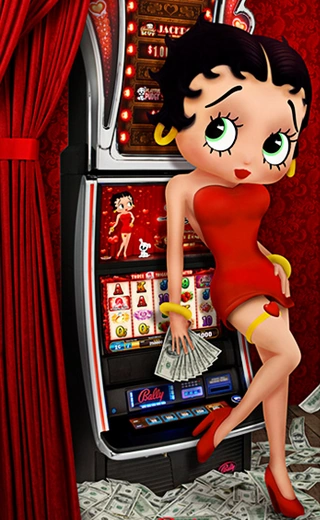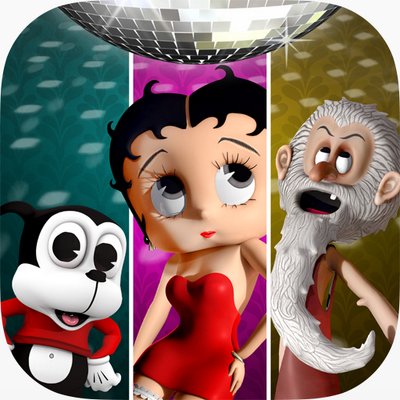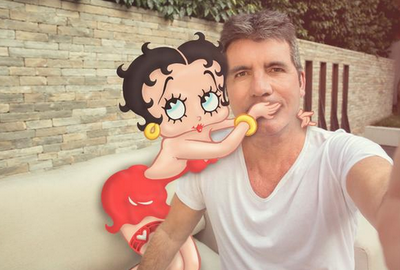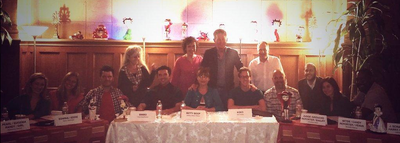"Who's that movie star shining brightly, people come from miles around to see her. It's not Mickey Mouse or Madonna, both of them would really like to be her."
Betty Boop is the main character of the series. She is a female cartoon character best known for her "Boop Oop a Doop" catchphrase, which is usually followed by a Bop, which is a high-pitched squeak often incorporated into her Boop routine. Betty is also known as Baby Boop or Bitsy Boop. She began as a caricature of 1920s singer and actress Helen Kane, the "Boop-Boop-a-Doop Girl", a plump baby-voiced singer who had become famous overnight after uttering "Poop Poop Padoop" in song in Arthur Hammerstein's show Good Boy, which debuted in 1928 at the Hammerstein Theatre. It was later discovered that Helen Kane had taken her Boop routine from a little-known African-American performer by the name of Baby Esther, who used to make small appearances in cabaret shows in Harlem during the early 20s. Betty Boop was also influenced by the It Girl (Clara Bow); Betty and Clara were often compared to one another, most significantly in Hollywood on Parade No. A-8. Betty Boop's creation was also influenced by the flappers of the roaring 20s. After the series rolled on, Betty Boop's mannerisms and traits were later based on Mae Questel, who often did the voice on a regular basis, starting from 1931. One of Betty Boop's traits taken from Questel was impersonation, which was Questel's speciality. Betty Boop first appeared in the Talkartoon Dizzy Dishes, which was released in 1930, as a plump anthropomorphic french poodle, and was originally portrayed by Margie Hines. Officially, Betty Boop was only 16 years old according to a 1932 interview with Fleischer (although in The Bum Bandit, she is portrayed as a married woman with many children and speaks in a deep tone of voice, rather than the standard baby-sounding Boop-Oop-a-Doop voice), while in Betty Boop's Birthday (which was released in 1933) Betty only has 14 candles on her cake, meaning that the character was three years younger than that before her birthday; this indicates that Max Fleischer could not decide on a actual age for Betty. The character was retired in 1939 but was later rediscovered in the 1970s but didn't quite make an impact until the 1980s where she became an iconic figure of the past and is still very popular to this day and has millions of fans all around the world.
Official Website
You can find out even more information and updates on Betty at Betty Boop's official website and the Fleischer Studios official website.
Betty Boop in the News
Betty Boop's Biggest Fans of the 1930s
Some of Betty Boop's biggest fans of the 30s were Jean-Paul Satre, Gertrude Stien, Maurice Chevalier who was a big fan of the Betty Boop cartoon series and Theodore Adorno, even during the Nazi period Betty Boop cartoons were shown in Germany with Max Fleischer's name aryanized to Karl.
Popularity in Japan
During the 1930s, Betty Boop's popularity soared in Japan. The distributor for the Fleischer Studios was Paramount who, according to their advertising, also handled Disney films in Japan. Paramount started to handle American films from its office in Tokyo from 1930. During that period Paramount's Tokyo branch promoted the Betty Boop series. After the character had become popular, she began to be referenced in Japanese media of the 30s. In the film Our Neighbor Miss Yae a Betty Boop cartoon can be seen being watched by a Japanese audience. The character's large eyes inspired Osama Tezuka's characters, one in particular was Princess Knight, where the character seems to have Betty Boop's hairstyle. The aesthetics taken from American animation would later go on to influence the creation and style of anime. The Fleischers responded to her popularity in Japan by releasing a cartoon entitled A Language All My Own, where Betty pilots a plane to Japan, wears a kimono and sings live to an audience in Japanese. Animator Myron Waldman was concerned that the depiction should be authentic, so he asked several Japanese exchange students to preview the film before it was released. Most original Betty Boop merchandise from the 1930s were made by small enterprises in Japan for the US popular market, but no records were kept of the unauthorized merchandise since copyright and trademark rules were not enforced. Apart from merchandise, Japan had its very own Betty Boop singer: Alice Hamada, known as Nippon Betty Boop, who released several Boop -inspired songs. In 1935, Haruyo Ichikawa recorded the Betty Boop theme song in Japanese. Betty Boop's popularity in Japan exists to this day, although most Japanese people today are unaware that the character was a star of her very own cartoon series and see her more as an icon, akin to Marilyn Monroe. In 2013, the character was featured in Line Play, a Japanese social application. Betty also appeared as an avatar for Coin Gatcha Betty Boop (TM) and the character was also portrayed by J-Pop artist Kyary Pamyu Pamyu for a Japanese Coca-Cola Halloween event in (2015). Koda Kumi also used Betty Boop as merchandise in 2016, for her Best Single Collection. You can also check Betty Boop's official Japanese website to keep updated and find out more on the official Fleischer Studios website.
Official Age
Betty is aged 13-16 in the original cartoon series from 1932-1934. In her earlier Talkartoons appearances she is portrayed as an anthropomorphic female dog (French Poodle). From 1935-1939 Betty is shown to live in her own residence, going to work and/or owning her own business. In the updated specials that were made in the 1980s (The Romance of Betty Boop and Betty Boop's Hollywood Mystery), Betty is identified as a woman. One reference in Betty Boop's Hollywood Mystery by Lola DaVille indicates that Betty is over the age of 16. Betty's official age is not stated on her website but it could be assumed that her age range is somewhere around 18-20. In media, she is classed as being 80 years old due to her creation in 1930. According to a Fleischer Studios promo featuring Betty, Betty Boop is 16 years old and will always stay 16. "Seize that woman! How dare you steal my treasure you little guttersnipe! Somebody call the police." (Betty Boop's Hollywood Mystery)
Character Design
Betty has an affinity for the colors black and red, she wears a short dress, and a garter on her left leg. Her breasts are highlighted with a low, contoured neckline that shows off her cleavage. In color Betty wears a red dress and red high heels with gold hoop earrings and gold bangles on each arm.
Eye Color
Betty is known to have blue eyes but can sometimes be seen with green eyes in official artworks where as classic Betty Boop has black eyes with no color.
Art featuring Betty Boop is printed in black & white the dotted lines indicating her eye irises do not appear. Betty's eyes are made up of only a black pupil and white eyeball. When printed in color Betty's irises print PMS 351 leaving the triangular highlights in the white pupils. The black dotted lines indicating Betty's irises never print. In special instances, the iris may be defined by a solid black line but only with permission of the Licensing Art Director. Betty Boop's eyes were altered in the Lancome Paris Star Eyes commercial and she can also be seen sporting eyeshadow.
Eye Colors
Black (Classic), Blue/Aquamarine (Poor Cinderella & Official), Green (Official).
Hair Color
Betty's official hair color is black but she was a red head in the 1934 short entitled Poor Cinderella. At that time there were several different color processes being tried. Walt Disney has secured exclusive rights from 1932-1935 to use what was called the 3-strip Technicolor process. Because Technicolor was unavailable to them in 1934, the Fleischers turned to another color process called Cinecolor in order to make the film. The animators made Betty's hair red in order to take best advantage of the limited color in this process. Betty Boop's official hair color is black and her hair is Red in Poor Cinderella (Cinecolor) and 1930s Fleischer Studios Adverts.
Little Ann Little's Claim
Little Ann Little "claimed" that the Fleischer Studios colored Betty Boop's hair red because she had red hair. Although this could be untrue as Little Ann Little was known to stretch the truth in her interviews. Another unusual claim from Ann was that Mr. Fleischer always said that she was the original Betty Boop and even had won a court case over her. The original voice of Betty Boop was in fact Margie Hines who portrayed the character in first two Betty Boop features, Dizzy Dishes and Barnacle Bill. Little didn't voice Betty until the third cartoon, which was also released in 1930, in which would also make her the "original" voice of Betty. Ann would often twist her interviews and state that she did a majority of the cartoons, taking credit for the other uncredited actresses.
Race & Religion
Betty Boop is Caucasian and is Jewish but unlike her parents Mr. & Mrs. Boop, Betty does not follow strict Jewish sects.
Betty Boop's Family
Grampy (Grandfather), Mr & Mrs Boop (Mother & Father), Billy Boop (Brother), Bubby Boop (Brother), Aunt Tillie (Aunt), Uncle Mischa(Uncle), Irving (Cousin), Buzzy Boop (Cousin), Junior (Nephew), Quintet Kiddies (Betty Boop's adopted children), 17 Kids (Betty Boop & Bimbo's children in The Bum Bandit, Wicked Queen(Betty Boop's wicked-stepmother in Snow White,Grandma (Betty Boop's Grandmother in Dizzy Red Riding Hood. In the 1930s Betty Boop comic strip, in one strip Betty's whole family gather at her home, but in the comic it doesn't mention their relation to Betty.
Samoan
In Betty Boop's Bamboo Isle, Betty has dark skin and is Samoan.The Samoan people are a Polynesian ethnic group of the Samoan Islands.
Origins
The character was originally created as an plump anthropmorphic French poodle, which was originally a take on Helen Kane, who's career had ended with Paramount a year later. The nameless character was only meant to have made a one-shot appearance, but the public loved the character so Paramount & the Fleischer Studios continued to develop the character. After the release of the 1930 short Barnacle Bill, Betty had became slimmer and her design was tweaked a little. Betty's skin tone was shaded darker in two shorts that followed Barnacle Bill which were; Mysterious Mose and The Bum Bandit.
In 1931 Betty's snout had became a button nose and her official design was similar to that of her human form only she was still an anthropomorphic French poodle. In 1932 (Betty can be seen without her ears in various Talkartoon releases in 1931 but it wasn't official until 1932), her floppy, poodle ears became hoop earrings and the character was later changed into a human and then started appearing in her own series as the main protagonist. The original canine Betty Boop with the snout was classed as ugly by her creators, due to the fact that she pulled some really ugly faces in her first appearance.
Margie Hines the Original Voice of Betty Boop
Marjorie Louise Hines won a Helen Kane imitation contest at a local cinema cathedral and was eventually seen by Billy Murray who worked for the Fleischer Studios. Hines then went on to create the voice for Betty Boop, which was based on the baby-doll styled sensation of the time and was asked to perform "I Have To Have You" for the cartoon entitled Dizzy Dishes which was a song that was previously recorded by Helen Kane which was a hit song and was featured in the film Pointed Heels which was released in 1929, one year before Betty Boop was created which also featured Kane. Margie Hines did the voice for Betty Boop from 1930-1932 and then signed a contract with the Van Beuren Studios, she continued to do voice-over for the Fleischer Studios and later reprised her role as Betty in 1938, and finished the series as Betty in 1939. While bringing out one of the orders in Dizzy Dishes, Bimbo randomly encounters the as-yet unnamed Betty Boop standing on a table singing. Betty was dubbed as being very "ugly" in her first appearance by her creators, so they worked on the character and transformed her around 1930 until 1932 when they had finalised the character's design. Margie Hines was a Helen Kane sound-a-like who was hired to record "I Have to Have You", meaning she was the first person to voice Betty Boop & the first female voice actress who had been with the Fleischer Studios, long before Mae Questel and Ann Rothschild were hired. And continued her role from 1930-1932 and was then replaced by several other voice actresses most promptly by Mae Questel. Hines still often continued to do voice-over work for the Fleischer Studios, alongside a few other studios (Van Beuren Studios & Terrytoons). Reason for Hines leaving the Boop role was she was to be featured in a Warner Bros. film feature The Perfect Suitor as the leading lady alongside Benny Rubin and wanted to pursue a solo career.
Betty Boop Cloned
In Bimbo's Initiation the French poodle version of Betty Boop clones herself, indicating that she the leader of a sex cult. In a secret society where she is worshipped by Betty Boop Clones.
Alternative Names
It is often quoted that Betty's name was inspired by the 1931 short Betty Co-ed. By 1931 her name was dubbed Betty in the 1931 short entitled Silly Scandals. Betty is nameless in Dizzy Dishes, Mysterious Mose & in Accordion Joe (lost cartoon) where she appears as a native American princess.
Names:
Barnacle Bill (Nancy Lee)
Nan McGrew (The Bum Bandit aka Dangerous Nan McGrew)
Dolly Prance (Any Little Girl That's a Nice Little Girl)
Kitty (Kitty From Kansas City)
Nellie (Wait Till the Sun Shines Nellie)
Baby Boop (Baby)
Bitsy Boop (Preschooler)
Betty-chan 『ベティ·ブープ』 (Japan)
Betti-san (1930s Japan)
The Boop-Oop-a-Doop Girl
Betty Boop's Residence
In the Betty Boop cartoon series Betty is seen living in a different home in each and every episode. In Bimbo's Express Betty is shown moving home, which indicates that she might do that on a regular basis, Where as in Minnie the Moocher Betty is shown to live with her parents. Following the later series Betty lives alone and sometimes with Pudgy. Places (See for information)
Helen Kane Look & Sound-alike Contests
Paramount Publix & the Fleischer Studios held a contest to find local talent, which was sponsored by Helen Kane. In one contest second place went to Jo Miller in one of the many contests that had been held by Paramount. Helen Kane opened her Helen Kane Impersonation Contest held through the country to all local girls in which was judged by the audience. The girl who looked and sung like Helen and "Boop-Boop-a-Dooped" most successfully was the winner. Mae Questel won first place in the final Helen Kane impersonation contest held at the Riverside Theatre in New York. Second place was a tie with Bonnie Poe and Margie Hines. Helen Kane: "I held amateur contests for amateurs that I thought it would be fun and would stimulate business in the theatre. We had Helen Kane's "Boop-Boop-a-Doop" contests and these girls came in and I heard them personally myself, and selected them, and then they appeared at the theatre one night during the week and they sang and they were awarded $25, or maybe a dress." Margie Hines won three "Boop-Boop-a-Doop" contests." Little Ann Little & Kate Wright had also entered the contests that were held by Paramount. Helen Kane had autographed a photo to Mae that said, "To Another Me." Mae later heard there was an audition for Betty Boop, so she auditioned for the role and was given a contract by the Fleischers, and started voicing Betty Boop in 1931, sharing the role with Kate Wright, Ann Rothschild, Margie Hines & Bonnie Poe. Little Ann Little stated the following; "Paramount were looking for a girl with a squeaky voice and I was given the part." Mae Questel stated the following; "I won a contest and bingo, I was signed that night and it was a big thrill and I loved doing Betty Boop!"
Betty Boop's Official Voice Actresses
Over the years Betty Boop has been voiced by Mae Questel, Ann Rothschild (aka Little Ann Little), Margie Hines, Kate Wright & Bonnie Poe, Melissa Fahn and Desirée Goyette. Today Betty Boop's voice is provided by Cindy Robinson & Sandy Fox in commercials. In Cindy Robinson's words; "Sandy is the more cuter, more high-pitched Betty where as Cindy herself is the sultry-sexy Betty." Cindy Robinson did several commercials as Betty Boop in (2013). In (2014) Heather Halley and Camilla Bard provided the voice for Betty for Betty Boop Dance Card.
Mae Questel the Betty Boop Girl
Mae Questel was a actress and singer who was most associated with Betty Boop. At the age of 17 she won a contest imitating Helen Kane as sponsored by Kane. Later Mae would impersonate stars from the 30s from Fanny Brice to Eddie Cantor. She was later discovered by Max Fleischer and was hired to do the voice for Betty in the 1931 Talkartoon Silly Scandals. According to Richard Fleischer: “Several squeaky female voices were tried out in the early Betty Boops, but none seemed exactly right. The voice needed to be squeaky, but it also needed to be cute and sexy, to sing, to do good line readings, and be able to say and sing “Boop-Oop-a-Doop” in exactly the right way. Max finally found what he was looking for in 1931 when he came across the incomparable Mae Questel. Her voice and Betty Boop became synonymous. Oddly enough, Mae looked exactly like Betty Boop." Mae provided the voice for Betty Boop from 1931-1938 when she retired to raise a family for a short while, she returned as Betty in the 1988 film Who Framed Roger Rabbit, 50 years later. In the early 30s Mae also used to portray Betty Boop in person, to promote the series alongside Max Fleischer.
It was originally thought that Mae Questel did the voice of Betty Boop for the entire Betty Boop cartoon series due to the fact that the original voice actresses were all uncredited for their roles as Betty Boop. Hines, Questel & Poe did a majority of the cartoons. Questel did the role of Betty Boop the most out of everyone who did the role in the original series and was known as the official voice of Betty Boop. Even after the character had been retired Questel was still relatively known for her role as Betty Boop and Olive Oyl another role that had been shared with Poe & Hines in the 30s.
Betty Boop's Voice Actresses (1930-Present)
1930s
1980s-1990s
- Victoria D'Orazi (1980)
- Desirée Goyette (1985-199?)
- Melissa Fahn (1989-2008) The Betty Boop Movie Mystery
- Cyndi Lauper (1989) (Originally was to have done the role of Betty in the CBS animated feature but was not committed to it.)
- Sue Raney (1993)
- Bernadette Peters (1981) (Was also considered for the CBS 1989 animated feature and scrapped 1993 MGM film.)
- Mary Kay Bergman (1993) (Stated she won the role for the scrapped MGM film.)
2000s
- Cheryl Chase (2002)
- Nicole Van Giesen (2003)
- Shannon Cullem (2004)
- Melissa Fahn (2004-2008)
2010s
- Lani Minella (2011)
- Heather Halley (2014) (Betty Boop Dance Card)
- Camilla Bard (2014) (Betty Boop Dance Card)
- Sarah Stiles (2016) (Fleischerei)
Present (Official Voices)
- Sandy Fox (1991- Present)
- Cindy Robinson (2009-Present)
Commercials/Other
- Didi Conn (A&W Root Beer)
- Angelia (2000) (Bally)
- Michelle Goguen (2001) (Garnier Lumina Hair Color)
- LeAnne Broas (2010) (Dan-e)
- Alex Borstein (Family Guy)
- Tara Strong (Drawn Together/Parody)
- Nippon Betty Boop/Alice Hamada (ニッポン・ベティ・ブープ)
- Kyary Pamyu Pamyu (Coca-Cola)
- Crystal Renn (Zac Posen)
- Ginger Pauley (Universal Studios)
Non-English Voice Actresses
Japanese:
- Mariko Mukai
- Chika Sakamoto (Who Framed Roger Rabbit)
- Horikawa Sanae
- Yūko Mizutani
- Akina Nakamori
Spanish/Latin:
- Mariela Romero (Spanish/Latin American Neutral)
Portuguese:
French:
Voice Actresses Trivia
Mae Questel ceased doing Betty Boop in 1938 as she retired from her show business activities to raise a family. The Betty Boop voice was then assumed by Kate Wright and most by Margie Hines, who also did Olive Oyl from late 1938 until 1943. Mae Questel returned to doing voice work for Famous Studios in 1943 for characters such as Olive Oyl and Little Audrey and was also the voice of Winky Dink the early interactive television show hosted by Jack Barry. Several of Betty's current voice-over talent have also provided voices for English dubbed Anime and have done Broadway as most of them specialize in high pitched girlish voices.
Betty Boop Record Recordings
During the early 30s Mae Questel made several recordings as Betty Boop entitled "Mae Questel the Betty Boop Girl". Questel covered several Shirley Temple songs including the hit song "On the Good Ship Lollipop".
Live-Action
Betty Boop has appeared in person in two official live-action shorts by Paramount Pictures.
Musical Justice (1931)
Betty is portrayed by Mae Questel in Musical Justice. Mae Questel performs "Don't Take My Boop-Oop-A-Doop Away" in a live-action sequence.
Hollywood on Parade (1933)
Betty is portrayed by Bonnie Poe in Hollywood on Parade No. A-8, alongside Bela Lugosi. Bonnie Poe performs "My Silent Love" in a live-action sequence. Bonnie Poe is often mistaken for Mae Questel and Helen Kane during her role as Betty Boop in Hollywood on Parade No. A-8. Helen Kane made a small cameo appearance a year before Betty's live-action appearance in Hollywood on Parade No. A-2 and two years before that she was featured in Paramount on Parade in her own skit where she performed a "Boop-Boop-a-Doop" number.
See Also
- Betty Boop Recordings (See for more information, on various song recordings)
Celebrities Featured in the Betty Boop Cartoons
Some of the biggest names of the 30s were featured in the Betty Boop series. Celebrities featured in the Betty Boop Cartoons (See for more information)
Betty Boop's Personality
Betty Boop is a light-hearted flapper reminding the audience of the carefree times of the Jazz Age. She was the first character on the animation screen to represent a sexual woman. All other cartoon girls of that time did not differ much from animated male characters, with only eyelashes, voice and outfit alterations to show their femininity. In Betty's earlier cartoons, male characters liked to put moves on Betty, and generally she provoked that. Besides, there was a certain girlishness in her personality, which was emphasized by her style of singing, sentimentality, and overall flapper-like behaviour.
Betty Boop's Quotes
Quotes:
1. "Nutsy-Doopsy!"
(When someone is trying to hurt her but fails)
2. "Fresh!"
(When someone tries to hit on her)
3. "Thank You, Thank You!"
(After performing in a show)
4. "Boop-Boop-a-Doop, Boop-Boop-Be-Doop, Boo-Boo-Pa-Doo, Boopy-Doopy-Doopy-Doo-Poop-Oopy-Doo, Boop-Oop-a-Doop-Bop, Boop-Oopy-Doop!"
(Betty's official quote, also used when singing)
5. "Don't be like that!/Don't be that way!"
(Comics Only)
6. "I'm too Pooped to Boop!"
(The Romance of Betty Boop)
7. "Betty Boop at your service!"
(Betty Boops Hollywood Mystery)
8. "Hi, I'm Betty Boop! Boop-Oopy-Doop! And would you believe that I'm from 1930? Don't I look good for my age, huh?"
(Universal Studios)
9. "Go Away! You Big Bad Man!"
(When a male character is harrassing her)
10. "Work's been kinda slow since cartoons went to color, but I've still got it Eddie! Boop-Boop-Be-Doop-Bop!" (Who Framed Roger Rabbit)
11. "Scram!"
(When she want's someone to get away from her)
12. "Pudgy, you weren't doing a very good job, now I've hired alley cat. He's a professional mouse catcher."
(Pudgy and the Watchman)
13. "Dear Betty, I can't mama wants me to mind Aloysius. Bimbo x x x x"
(Minding the Baby)
14. "Oh, my dear, I hope it's a man..."
(Someone rings her doorbell, Betty Boop's Birthday Party)
15. "Where ya going bunny huh?"
(Betty Boop in Blunderland)
16. "As you sow so shall you grow, so sow!"
(The Scared Crows)
17. "I'm Betty Boop and I Wanna Be Loved By You & Only You! Boop-Oop-a-Doop!"
(Modern Quote)
18. "Oh, Gee real Indians!"
(Rhythm on the Reservation)
19. "Say, Grampy how about some music?"
(Betty Boop and Grampy)
20. "Aww, you hurt your little head? Now Pudgy you stay here and take good care of him!"
(The Scared Crows)
21. "And Betty Boop is my name, don't you forget it! And Boop-Boop-a-Doop is my game!"
(The Romance of Betty Boop)
22. "I'm just a bubble in trouble! She's gotta be stopped they want this diamond won't someone here please call the cops!"
(Betty Boop's Hollywood Mystery)
23. "Bally & Betty back together again!"
(Betty Boop's Love Meter)
24. "Are you ready to Boop? Boop-Oop-a-Doop-Boop!"
(Betty Boop Dance Card/Betty Boop Bop)
Theme Song
Betty Boop's official title theme song is "Sweet Betty" and her character image theme song is "Don't Take My Boop-Oop-A-Doop Away" which was written specially for the character by Sammy Timberg. According to Helen Kane the song was orginally written for her and was shown to her first. Since the 1980s Betty's official theme song was changed to "I Wanna Be Loved By You". Most of the songs Betty sung in earlier Betty Boop cartoons originated from Helen Kane, such as "I Have To Have You", "Do Something" and "That's My Weakness Now". In later cartoons most of the songs Betty sung were written by Sammy Timberg, and were also later featured in some Popeye cartoons.
Betty Boop's Abilities
Betty Boop is able to play the piano as seen in several episodes such as, Betty Boop's Crazy Inventions, A Hunting We Will Go, Betty Boop's Birthday Party, Happy You and Merry Me, & Be Human. Betty Boop can impersonate anyone and is seen as a Impersonator in the first Betty Boop episode entitled Stopping the Show. Including such celebrity's from the 1930s as Maurice Chevalier, Fanny Brice, Helen Kane. Betty can also be seen impersonating Herbert Hoover & Al smith in Betty Boop for President, although she actually morphs into them. Although Betty's voice actress Mae Questel was a impersonator so that trait came from Questel. Mae Questel stated in a interview, that some of Betty's personality was based on her own. In On With the New, Betty is shown to be able to run at a high speed. Betty is shown to be able to cook but not very well as first seen in Betty Boops Bizzy Bee where she is shown running her very own Diner. In later episodes Betty is an excellent cook, she even works as a chef in On with the New.
Betty Boop's Jobs
In the early Betty Boop cartoon series, Betty has been shown to have many different jobs. Officially Betty Boop worked in Vaudeville as seen in Dizzy Dishes, Silly Scandals, Stopping the Show, Making Stars, Pudgy takes a Bow-Wow & The New Deal Show. Jobs: Nurse, Chef, Secretary, Babysitter, Judge, Nanny, Penny Arcade, Inventor, Race Car Driver, Actress, School Teacher, Automobile Car Repair Woman, Waitress, Shoe Sales Woman, Dancer, Circus Performer, President.
Betty Boop's Friends
Bimbo the dog (Ex-Boyfriend/Best Friend), Koko the Clown (Second Best Friend), Little Jimmy (Friend), Popeye (Friend), Pudgy (Pet), Henry (Friend), Mr & Mrs Boop (Mother & Father), Sally Swing (Friend), Fearless Fred (On & Off Boyfriend), Wiffle Piffle, Beverly (Best Friend) See Also: Betty Boop's Animal Friends (Rudy Vallee Melodies)
Betty Boop's Enemies
Wicked Queen, Miss Green, Sam Slade, Willy Wolf (Dizzy Red Riding Hood), Ugly Stepsisters, Johnny Throat, Ringmaster, The Old Man of the Mountain, Lecherous Old Man, Big Boss, Mrs Fritzi Prissy, Gus Gorilla, Irving (Cousin) ,Tracy & Mimzy.
Betty Boop Information
It has been assumed that Betty's first name was established in the 1931 Screen Songs cartoon, Betty-Co-ed, this "Betty" is an entirely different character. Even though the song may have led to Betty's eventual christening, any reference to Betty Co-ed as a Betty Boop vehicle is incorrect although the official Betty Boop website describes the titular character as a "prototype" of Betty. There are at least 12 Screen Songs cartoons that featured Betty Boop or a similar character. Betty appeared in the first "Color Classic" cartoon Poor Cinderella, her only theatrical color appearance in 1934. In the film, she was depicted with red hair as opposed to her typical black hair. Betty also made a cameo appearance in the feature film Who Framed Roger Rabbit (1988), in which she appeared in her traditional black and white and was voiced by Mae Questel. Betty Boop appeared in two television, both specials are available on DVD & Video as part of the Advantage Cartoon Mega Pack.
$250,000 Infringement Lawsuit
In May 1932, Helen Kane filed a $250,000 infringement lawsuit against Max Fleischer and Paramount Publix Corporation for the "deliberate caricature" that produced "unfair competition", exploiting her personality and image. While Kane had risen to fame in the late 1920s as "The Boop-Oop-A-Doop Girl," a star of stage, recordings, and films for Paramount, her career was nearing its end by 1931. Paramount promoted the development of Betty Boop following Kane's decline. The case was brought in New York in 1934. Although Kane's claims seemed to be valid on the surface, it was proven that her appearance was not unique. Both Kane and the Betty Boop character bore resemblance to Paramount top-star Clara Bow. The most significant evidence against Kane's case was her claim as to the uniqueness of her singing style in which she swiped from a African-American performer by the name of Baby Esther.
Helen Kane Lawsuit Bargain
According to Leslie Cabarga (Who had met Mae Questel in person), Helen Kane went to Max Fleischer and said if you use me in the cartoons instead of the other girl (Mae Questel) I'll drop the suit. Max who knew Mae Questel said; "I won't use anyone but my Mae", meaning he had declined Helen's offer.
Comparison Between Helen Kane & Betty Boop
Miss Kane's attorneys strove vainly to have the sound effects included. Saying they wished to show how Betty Boop had simulated "their" voice and their style. They wanted to show the Judge that the defendants have made a studied imitation of their style, our movements of the eyes and their general mannerisms. Max Fleischer denied that Betty Boop was a caricature of Kane and referred Clara Bow. which was false, Clara Bow was part of the inspiration when re-vamping Betty Boop. But Betty Boop originally started as a caricature of Helen Kane in the 1930 cartoon Dizzy Dishes which was proven by a statement later made by Grim Natwick. The idea of the Boop character was originally created by animator Grim Natwick. Who claimed her had used a photograph of Kane when first he had created the character under contract of the Fleischer Brothers. In several of his interviews he references Helen Kane as his model for the character and had also mistaken her for providing the actual voice for Betty Boop in the first cartoon. Helen Kane however did not provide the voice for Betty Boop. Betty's voice was provided by Helen Kane impersonators. Betty's hair was even changed red, in the only Betty Boop color cartoon Poor Cinderella to try and change Betty's appearance to differ to Kane. Betty's official hair color is Black. Little Ann Little who was hired to play Betty Boop in person was also a red head. Apart from Clara Bow, Mae West was also later stated as being the model and or influence for Betty Boop, In 1932 there was even a trade ad which showed Betty Boop next to a photograph of Helen Kane.
Betty Boop's Trial
The cartoon Betty Boop's Trial which was released in 1934, is most likely a reference to the Helen Kane $250,000 Lawsuit, but with a different story which show's Betty Boop go to court for speeding in her Automobile, which ends with Betty Boop winning. The music which is played for the title screen is "Don't Take My Boop-Oop-A-Doop Away" which hadn't been used in the entire Betty Boop cartoon series since (1932) and was then used in the Fleischer Victory Newsreel after winning the suit against Kane.
Removed Helen Kane Scene from Stopping the Show
The first Betty Boop cartoon Stopping the Show featured a placard of Helen Kane impersonated by Mae Questel asking Betty Boop to impersonate her. Before the Fleischer Studios showed all cartoons featuring Betty Boop compared to Helen Kane the Fleischers removed the scene before showing it to the Judge. The scene in all future prints after the trial cuts straight to Betty Boop singing "That's My Weakness Now", Fanny Brice (Also impersonated by Mae Questel) and Maurice Chevalier's scenes are not removed. According to valid information Helen Kane saw the original print of Stopping the Show and launched a lawsuit against The Fleischer Studios and Paramount.
Placard Information
Betty comes out on stage. There is a pan left across the audience to the stage in long shot. In the distance is a vague impression of a placard with the image of what looks like Helen Kane.Then the cartoon cuts, with the soundtrack splice audible, to Betty singing the song, "That's My Weakness Now." This was a song sung by Helen Kane, and is the only piece not set up with the talking photographs as with the others.
Betty Boop for President Franklin Roosevelt (Removed Scene)
In Betty Boop for Presidentas Betty's head morphs from caricatures of Hooverand Al Smith, the one of Franklin Roosevelt has been removed, and there is an off-beat jump in the soundtrack as a result.
Testimony
Testimony revealed that Kane had witnessed an eight year old African-American performer, Baby Esther, using a similar vocal style in an act at a the Everglades Club on Broadway. An early test sound film was also discovered which featured Baby Esther performing in this style disproving Kane's claims that she was the first to Boop.
Victory Newsreel (1934)
Max Fleischer responded to the Helen Kane by releasing a Fleischer Victory Newsreel, which featured five of the women who provided the voice for Betty Boop. Mae Questel, Margie Hines, Little Ann Little, Bonnie Poe & Kate Wright. Max Fleischer stated that the women all had a "certain something in their voices." Mae Questel took the lead role and sung "Don't Take Our Boop-Oop-a-Doop Away", with backup from the four other voices of Betty Boop. "You can say our voices are awful, or my songs are too risqué. But don't take our Boop-Oop-a-Doop Away!"
Helen Kane's Response
Helen Kane later told the press that she was shocked and disappointed, adding that both she and her friends felt that Betty Boop was a deliberate caricature of her. Kane went on to tell the newspapers that it wasn't the money, it was the fact that they had stolen her idea. Helen Kane: "I am MAD!, MAD!, MAD! I am so mad! I am going to spend a lot of money appealing this case. They have stolen my idea! I don't need money. I sued these Betty Boop people for $250,000, I don't want a cent of it. All I want is vindication. It has broken my heart."
Helen Kane Using Betty Boop's Image Without Permission
Helen Kane never provided the voice the animated character Betty Boop, but is often mistaken for the voice of Betty Boop. Helen later went on to use Betty Boop for her posters two years later in 1935 for her Fox Brooklyn shows. The show even featured a Betty Boop cartoon. Max Fleischer was told by one of the newspapers at the time to sue Kane, but he didn't and let her use Betty Boop without permission. Helen Kane wanted Betty Boop stopped by injunction. Helen Kane was originally flattered with the character Betty Boop until she got mixed up for being the voice of Betty Boop and a Betty Boop Impersonator. Helen stated the following: "I have become a ghost... Recently in Hollywood when some children ran to open the door of my car they greeted me as Betty Boop. Betty is just one stroke removed from Mickey Mouse." After Kane had attempted to sue the Fleischer Studios, from there on Max Fleischer had no nice words to describe the actress. According to a Brooklyn newspaper that Max Fleischer read regularly in which stated that they were not supposed to mention Helen in favor of Mr. Fleischer.
Helen Kane's Famous Trial Scene Show (1934)
In late 1934 Helen Kane opened a show at the Plaza Cafe with Harry Carroll, a famous vaudeville star and producer where she did her famous trial scene (a show based on the $250,000 Infringement Lawsuit). The "Booper" comes here at probably the highest salary ever paid a performer in a local night club.
Character Copyright
Betty Boop has been in and out of court which has been ongoing for several decades. The reason the suits was who had actually owned the rights to the character. Aside from the $250,000 Helen Kane 1932-1934 lawsuit Harvey Films (also known as Harvey Entertainment, The Harvey Entertainment Company or simply Harvey) an animation production arm of comic book publisher Harvey Comics which was founded in 1957 were sold the rights to Betty Boop in the 1950s and according to information in the 1970s the Fleischer family tried to buy the rights back to the character and were convinced they were the exclusive owner of Betty Boop. According to court details Harvey were going to reboot Betty Boop “Presumably to make new movies featuring the character, although there is no evidence they ever did" minus a drawing of Betty Boop from the 1950s that most recently surfaced. It was announced in 2011 that the Fleischer family did not own the copyright or trademark of Betty Boop and cannot sue others for using the character's image. The Ninth Circuit Court of Appeals upheld a lower court’s decision that a half-dozen manufacturers of Betty Boop merchandise hadn’t infringed on Fleischer Studios’ copyright because the Fleischer Studios couldn’t demonstrate it has one. The Fleischer family contended that Paramount transferred its Betty Boop rights in 1955 to UM&M TV, which three years later sold them to the company that eventually became Republic Pictures. A decade later, Republic allegedly transferred the rights back to Fleischer Studios. Judge Florence Marie Cooper ruled the Fleischer heirs failed to show proof of any of the transfers the plaintiffs alleged took place after Paramount purchased the rights in 1942. The appeals court agreed in a 2-1 decision, finding that Paramount retained the copyright in its 1955 agreement with UM&M TV, and actually sold Betty Boop to Harvey Films the animation arm of Harvey Comics, now owned by Classic Media some three years later. The panel also dismissed Fleischers’ trademark claims for lack of evidence. It was later found out that the Betty Boop character is a Fleischer trademark but it can’t be used to stop people from redistributing old PD Betty images/items of the character. The Fleischer family tried to say trademark trumped copyright but the Judge said that it doesn’t. One of the main parts of Harvey claiming they owned the character was whether Paramount legitimately sold the Betty Boop trademark to Harvey. According to Leslie Cabarga; "King Features maintained that they owned the rights to Betty Boop on having issued a Betty Boop comic in the 1930s. King Features agreed to the concept of Max Fleischer family co-ownership because it was easier than trying to unravel true ownership in which it might be revealed that King Features did not actually own Betty. A King Features lawyer told me once in the 1970s that at one point The Fleischers tried to take ownership of Betty away from them but King basically told them to "GO TO HELL!" Which indicated to me that the Fleichers really had no power in the situation. Same lawyer also told me definitely that their research showed that Koko was in the public domain." Today Betty Boop is fully branded by King Features Syndicate.
1941
In 1941 the Fleischer Studios had given all the rights to the character to Paramount.
1955
In 1955 the appeals court considered between Paramount and UM&M TV Corp. The assignment in 1955, under the Copyright Act of 1909. Paramount had granted UM&M all of Paramount's right, title and interest and Photoplays of Betty Boop. Anything to the contrary notwithstanding, no grant or assignment is made hereunder to [UM&M] of the characters and characterizations contained in said Sold Photoplays or said literary material, or of the copyrights in said characters or characterizations, or of any production or other rights in said characters and characterizations, or to use said characters and characterizations or the names of said characters or trade names, trademark and names of the series of Sold Photoplays or of said literary material in any manner except only as part of the particular Sold Photoplay in which they or any of them are contained.
1958
In 1958 Paramount gave the rights to Harvey Films Inc. Harvey went on to license the character in the 1960s.
1980
In 1980 Harvey Cartoons transferred Betty Boop to Alfred Harvey. It was often stated that Paramount might have not legitimately sold Betty's trademark to Harvey.
2006
In 2006 the Fleischer Studios sued AVELA who were selling Betty Boop on posters. The family of the creator of Betty Boop Max Fleischer lost the suit. As the Fleischer Studios INC at the time could not prove it had title to the character. The Judge stated that if they had ruled that AVELA's depictions of Betty Boop infringed the Fleischer trademark the character would never enter the Public Domain. The Judge also said that AVELA Inc licensed Betty Boop dolls, T-shirts and handbags under a copyright based on vintage posters and it did not infringe any trademark. The Judge then pointed to a 2004 Minnesota search warrant that turned up a large ceramic Betty Boop doll with four concealed, separately wrapped plastic bundles of high-purity-level methamphetamine inside.
2010
In 2010 the case with A.V.E.L.A., Inc., ArtNostalgia.com, Inc., X One X Movie Archive, Inc., and Leo Valencia (collectively, A.V.E.L.A.) A.V.E.L.A., INC., DBA Art & D.C. No. Vintage Entertainment Licensing was argued and submitted.
2011
In 2011 the case was filed defendants in this action,A.V.E.L.A., Inc., ArtNostalgia.com, Inc., X One X Movie Archive, Inc, and Leo Valencia (collectively, A.V.E.L.A.) , who also license Betty Boop merchandise. The copyright pursuant to which A.V.E.L.A. licenses its products is based on vintage posters featuring Betty Boop’s image that A.V.E.L.A. had restored. A.V.E.L.A. disputed this alleged chain of title, arguing that there was no admissible evidence to establish each link in the chain with the exception of the transfer from Original Fleischer to Paramount. The district court agreed and held that Fleischer failed to satisfy its burden of proof regarding the transfer of rights from UM&M to NTA and from NTA to Republic Pictures. The Judges that if they had ruled that A.V.E.L.A.’s depictions of Betty Boop infringed Fleischer’s trademarks, the Betty Boop character would essentially never enter the public domain. Such a result would run directly contrary to Dastar. 539 U.S. at 37 (“To hold otherwise would be akin to finding that § 43(a) created a species of perpetual patent and copyright, which Congress may not do”). Boop, it cannot assert a trademark infringement action against A.V.E.L.A. Given that A.V.E.L.A.’s use of Betty Boop is functional and aesthetic, and because ruling in Fleischer’s favor would prevent the Betty Boop character from ever entering the public domain, Fleischer’s infringement claim is barred by Job’s Daughters and Dastar. In light of their holding, they also deny as moot Fleischer’s motion to take judicial notice of the incontestable status of its trademark registrations.
2014
In 2014 the High Court delivered two judgements in the landmark character merchandising case. The claimants Hearst Holdings based in New York and The Fleischer Studios Inc based in Califorina. Hearst owned various Betty Boop UK trademarks and Community Trademarks (CTMs) co-owned by Fleischer, including the work mark Betty Boop and the iconic device mark depiciting the image of Betty Boop posing. The defendant being AVELA a US based company. The claimants issued proceedings for trademark infringement of the UK marks and CTMs. AVELA contended that it was a legitimate source of Betty Boop imagery and that any Betty Boop imagery was purely decorative and made no representation about trade origin and could not, therefore constitute trademark infringement. The Judges view was that Betty Boop was not famous today because she was a 1930s character. Many people unlikely seen the cartoons but because of the claimants, extensive licensing and trading activities in the UK since the 1980s. The associations with the Betty Boop character in today's society were more than just a reference to the 1930s era. The character had been modernised and had a current up-to-date appeal. The claimants had continually worked hard to develop the Betty Boop brand and had educated the public to recognise the Betty Boop words and images as a brand. The Judge accepted that in some circumstances the public was aware that two concrete examples of actual confusion were proven at trade level. Despite it being a condition of AVELA's licences that licensees could not use the words Betty Boop, Boop or Betty alone. Or any slogan such as Boop Oop a Doop. The Judge found this was insufficient to avoid confusion. The Judge rejected the defendants contention that their use of Betty Boop was purely decorative and not being used as a badge of orgin. The Judge ruled that the images were not descriptive indications. Many of the images in the library had no connection to the film posters at all. Even if the defendants did own the copyright in the restored posters, it did not give them the right to exploit the work, nor infringe another's trademark. The claimants were successful when the Judge dealt with two issues that arose after his main judgement. The defendants alleged that the claimants had “no rights (eg, copyright)” in the Betty Boop character, so the trademark applications were made in bad faith and the marks were invalid. They also alleged that the goodwill and reputation built by the claimants was founded on a misrepresentation as to the ownership of copyright. The main judgment had already found that the Betty Boop words and image marks were distinctive when the defendants began trading in 2009, and had also acquired distinctiveness when they were registered in 1992. The registrations were therefore valid as the claimants had rights under the law of passing off. The goodwill and reputation had not been based on misrepresentation about ownership of copyright, but based on the claimants’ extensive use of their trademarks. The judge held the UK court did have jurisdiction to hear the English proceedings because the Italian and English actions were not based on the same facts. The judge declined to stay the proceedings on the special grounds that he had already given judgment. This case also distinguishes between cases involving invented characters and real people. While the judge clarified that there was no law that granted invented characters stronger rights than real people, he admitted it would probably be easier to educate the public to believe that goods relating to an invented character came from a single source than it might be for a real person, especially given that copyright law could give the inventor of that character the ability to control the reproduction of that character for a long time. However, that same judge also ruled in Fenty v Arcadia, that the pop star, Rihanna, could prevent reproduction of her image on a t-shirt in Topshop.
Betty Boop Comic Strip
In 1934 Betty Boop's comic strip was launched. The strip was re-released in 2015 by Titan Comics and also featured The Original Boop-Boop-a-Doop Girl by Helen Kane. In 2015 Dynamite Comics announced a new deal with Fleischer Studios and King Features to publish a new Betty Boop comic.
1935-1937
Betty made appearances on the front cover of the Fleischer's Animated News, where she appeared in some of her own skits with Grampy, her nephew Junior, Popeye and Olive Oyl.
The Romance of Betty Boop (1985)
Betty Boop is a girl adored by her neighbors and a hard worker. She sells shoes in a shoe store along the day, and sings at the Club Bubbles at night. Desirée Goyette was picked to voice Betty out of 55 actresses. Betty Boop changes her outfit several times and has a pet parrot called Polly instead of her regular pet pooch Pudgy the dog. Betty doesn't wear her garter belt throughout whole film even though the hays code rules are long gone and the garter is one of Betty's main trademarks, Betty's garter re-appears in the next film Betty appears in "Who Framed Roger Rabbit" which was made 3 years after The Romance of Betty Boop. Betty's design in the film resembles Grim Natwick's drawings he did of Betty in the 70s & 80s. This is the first time Betty has sung Helen Kane's signature song "I Wanna Be Loved By You" and made it her own.
The Betty Boop Movie Mystery (1989)
Betty Boop works as a waitress in a diner with her friends Bimbo and Koko the Clown. Melissa Fahn provides the voice for Betty Boop and has replaced Mae Questel & Desirée Goyette. In Los Angeles, Betty Boop works as a waitress along with her friends Koko and Bimbo. This is the first appearance of Bimbo since 1933, who appears the color blue instead of black. The movie was made a year after Betty's cameo in the 1988 animated Disney film Who Framed Roger Rabbit. Betty's outfit has been changed to purple instead of the usual red and her jewelry had been changed to silver instead of gold, her garter is also visible, unlike when she appeared in The Romance of Betty Boop. Unlike The Romance of Betty Boop, The Betty Boop Movie Mystery attempts to follow Max Fleischer's original surreal style of the original Betty Boop cartoons.
Betty Boop Scrapped Film (1993)
In 1993 Richard Fleischer who was the son of Max Fleischer of the Fleischer Studios wanted to make a feature out of his father's star character "Betty Boop" but those plans were later scrapped. Jazz was a major part of most of the old Betty Boop cartoon shorts. In the storyboard in the link above Betty Boop performs a song called "Where are you" with her estranged father Benny Boop. Sue Raney substitutes for Betty & Jimmy Rowles stands in for Betty's father Benny Boop. Bernadette Peters was to have voiced Betty in the actual movie which would make the storyboard a pilot but before the recording sessions started the film was abandoned. According to Mary Kay Bergman she had auditioned for the role and had been given the part, until it was abandoned. The music was written by Benny Wallace and lyrics by Cheryl Ernst Wells.
Betty Boop TV Series (1996)
Richard Fleischer was shopping around for a Betty Boop TV series where Betty would be a intergalactic flight attendant, but plans for this were later scrapped.
Betty Boop's Misguided Tours Scrapped TV Series (1998)
Betty Boop's Misguided Tours was a TV show about Betty Boop as a tour guide on a bus that travelled to various places around the world. The show was supposed to have been hip and edgy. The show was pitched to MTV and HBO. The project was scrapped.
Betty Boop CGI (2001-2002)
In 2000-2001 a new Betty Boop TV series was going to be created in CGI (Betty Boop CGI) by The Fleischer Studios, King Features with help from Mainframe Entertainment Inc., but plans for the feature were later scrapped.
Other Appearances
Betty made cameo appearances in television commercials and the 1988 feature film Who Framed Roger Rabbit (1988). While television revivals were conceived, nothing has materialized from the plans. In 1993 there were plans for an animated feature film of Betty Boop but those plans were later canceled. The musical storyboard scene of the proposed film can be seen online. The finished reel consists of Betty and her estranged father performing a jazz number together called "Where are you?" the music by Benny Wallace and lyrics by Cheryl Ernst Wells. Jimmy Rowles and Sue Raney provide the vocals for Betty and Benny Boop. In 2007-2008 Betty appeared in the Nintendo DS Game Betty Boop's Double Shift. In 2009 she appeared in a mobile game by Namco called Betty Boop Movie Mix Up. A Betty Boop Musical is in development for Broadway with music by Davis Foster.
Nintendo DS (2007-2008)
The first ever playable Betty Boop game was released in early 2007-2008 by DSI Games entitled Betty Boop's Double Shift. The game was dissed by Nintendodojo who gave it very poor ratings, it was also criticized for the unresponsive touch controls.
Betty Boop & Bally Technologies (2011-2015)
Betty Boop has appeared in several slot machine games with Bally Technologies starting with Betty Boop's Love Meter which was then followed by Betty Boop's Fortune Teller, Betty Boop's Firehouse and Betty Boop's 5th Avenue. Two of which were ported to the ipad/iphone for itunes. The game features Cindy Robinson who is the official voice of Betty for the Bally game releases. Robinson provided the voice-over for Betty for Bally for five years running. The slot machines are often feature CGI openings and Betty speaks directly to the player. Bally has a vast history with the cartoon character Betty Boop, during the 90s Bally hired a Betty Boop impersonator known simply as Angelia who worked as a MGM Betty Boop impersonator. She started out as Betty in 1993 and later went on to portray Betty in person for Bally where she was a integral part of promoting the slot machines for casino managers and none other than the Fleischer family, including Max Fleischer's son Richard Fleischer. Angelia worked with Bally from 1999-2000, then retired from portraying Betty in 2003. For the opening of Betty Boop's Love Meter, Betty can be heard saying "Bally and Betty back together again!" The slot machines featured at Casinos are known to be quite popular with guests.
Betty Boop Dance Card (2014)
In 2014 Betty Boop was featured in Betty Boop Dance Card by game designer Mickey Blumental of Fowl Moon Studios an IOS rhythm action card game on IPhone & IPad. The game was quickly followed by Betty Boop Bop and Betty Boop Beat. The game opening sequence features Heather Halley as Betty Boop and David Babich as Bimbo. In the game Betty's voice and singing vocals are provided by Camilla Bard.
The Betty Boop Movie
In 2014 it was announced by Simon Cowell that he would be producing the Betty Boop the Movie partnering with Animal Logic. Leaked emails suggest that the role of Betty was originally to have been played by Lady Gaga and suggested that the film will be a live action hybrid along the lines of Who Framed Roger Rabbit. It has been suggested that the Syco Entertainment & Animal Logic Betty Boop film feature had been cancelled. Instead Betty will make her debut in a new TV series in 2018. Syco & Animal Logic have yet to comment. Although the immediate release for the film is still featured on the Animal Logic website and it has been indicated that the project is still secretly in the works.
Normaal Animation Betty Boop Series (2018)
Betty Boop is set to return in a new series Betty Boop Series (Normaal Animation) in 2018 by Normaal Studios. Betty Boop takes center stage in a new animated series being developed by Normaal Animation (Peanuts), marking the first time the iconic character will star in her own show in three decades.
Betty Boop Musical (2018)
A Betty Boop Musical has been in the works since 2002. Jason Robert Brown was hired to write the music for the show but was later fired. Sandy Fox the official voice of Betty Boop stated she originally was given a role in the show as Baby Boop but the show was scrapped. Five years later there was a whole new creative team featuring David Foster. In 2014 David Foster posted an update on the Broadway show and said that they were in their first reading for the musical. According to information the Broadway musical is set for fall 2018.
Betty Boop Referenced in Other Animation & Media
- Betty Boop Parodies & References (See for more information)
See Also
- Betty Boop Commercials (See for more information)
Betty Boop Toys & Games
Betty Boop Toys & Games & Products, include Betty Boop Precious Kids Dolls, which are the official Betty Boop dolls. The first Betty Boop Doll was made in 1931, a replica was remade by Danbury in 2005, Danbury Mint still make porcelain Betty Boop dolls which are collected by fans of Betty Boop, although the Danbury Mint Betty Boop dolls are very expensive. Betty Boop's Love Meter was released for the iPad in early January 2012.
Betty Boop Updates
On the 29th of April A Day With Baby Boop (2013) was released on iTunes.
It was also announced that Betty Boop would get a new makeover entitled Betty Boop Zombie Love.
In August 1st Betty Boop has been featured in a Japanese online avatar game entitled "Line Play" to see more information "Betty Boop featured in Line Play".
In Spring (2014) Betty Boop is set to appear in Betty Boop Dance Card a card collecting rhythm game by Fowl Moon Studios.
On the 14th of August 2014 Simon Cowell (Syco Entertainment) announced that he was working on a feature length Betty Boop film with Animal Logic, Betty Boop replied to Simon via Twitter explaining the following "I'm so excited to return to the big screen - and I only work with the best! Let's have some fun Simon Boop-Oop-a-Doop!". Simon replied by stating "Betty is an icon, and one of the biggest stars in the world - I'm thrilled to be working with her, Betty I've worked with some diva's but I think you could be the biggest of them all!" See (Betty Boop the Movie for more details.
Multi-million dollar retail property that continues to dominate at retail around the world, from mass market to high end specialty and boutique. Has 150 licensees in the US and 250 internationally producing merchandise in virtually every category. Powerful brands have associated with Betty Boop: Cola Cola, NASCAR, Bank of America, Lancome, Joyrich, Uniqlo, Forever 21, BrasNthings, Fiorella Rubino, Hamilton, Lottery Tickets, Fowl Moon Studios, King Features, H&M, Universal Studios Theme Parks, Animal Logics. Betty Boop is a featured consumer marketing campaigns supported by multi-million dollar advertising companys such as the Bradford Exchange, The Danbury Mint and Checks in the Mail.
Betty has over 1.6 MM followers on Facebook and over 4.5K followers on instagram growing every day.
A spin-off of Betty Boop Dance Card entitled Betty Boop Bop was released and also ported to iOS in March 2015 renamed Betty Boop Beat.
A new App on the IOS entitled Dress Betty Boop was launched in May.
On July 7th 2015 it was announced that Betty Boop would be featured in a new comic strip by Dynamite Comics.
In 2015 Betty appeared in Betty Boop's 5th Avenue by Bally.
In 2015 two official Betty Boop singing plush dolls Betty Boop TM & Pudgy (2015) and Graduation Betty Boop TM (2015) were released by Chantilly featuring vocals by Sandy Fox the official voice of Betty Boop.
In 2016 Betty Boop and Popeye were featured by Jean Paul Gaultier perfumes. Betty later appeared in a special animated web comic entitled Spinach and Stockings.
A tribute album to Max Fleischer cartoons by Gary Lucas known as Fleischerei was released in 2016. The album features song covers from the Betty Boop & Popeye cartoon series.
In 2016 new official Betty Boop singing plush dolls Birthday Betty Boop TM and Nurse Betty Boop TM released by Chantilly featuring vocals by Sandy Fox the official voice of Betty Boop.
It was announced in mid 2016, that Betty Boop would be getting a new dress courtesy of Zac Posen.
Two more official Betty Boop singing plush dolls Christmas Betty Boop TM (2016) & Halloween Betty Boop TM (2016) were released by Chantilly Lane.
In February Dark Hall Mansion released limited edition Betty Boop prints.
In March Betty was featured in as a free download for the Apple Watch application Facer.
On the 6th of March a limited edition Betty Boop make-up kit was released by Z Palette.
In July it was announced that Betty would be featured in a brand new comic strip by Dynamite Comics: Betty Boop, the comics was previewed in August and launched in October.
A brand new 1950s American themed diner (Betty Boop's Diner) opened in Tokyo in 2017.
On the 7th of February 2017 Betty was dubbed Heroine of Hearts for Woman's Day.
Betty was also featured in a Zac Posen Collection in collaboration with MAC which included an animated short entitled Betty Goes A - Posen featuring Sandy Fox.
In the 2017 May issue of Elle Magazine Betty Boop was featured with an updated wardrobe design. The special feature re-imagines Betty as "the consummate ELLE woman, circa 2017; an in-demand Manhattanite, running the show in a new, very now job (chief ideas officer at music-streaming start-up Music.ly), with a wardrobe hot off the spring runways." The Elle illustrations featuring Betty Boop were drawn by Anne Rufin a French-American who does Visual & 3D Animation for Elle magazine.
Betty Boop Now was released on the 23rd of June 2017.
(2013-Present)
According to Mark Fleischer there are no plans for any new Betty Boop cartoons, but a Broadway musical has been in the works for several years and should have opened in fall 2014 but will most likely be released in the near future. In 2016 it was later announced that Betty would make her debut in a brand new TV series starting in 2018.

